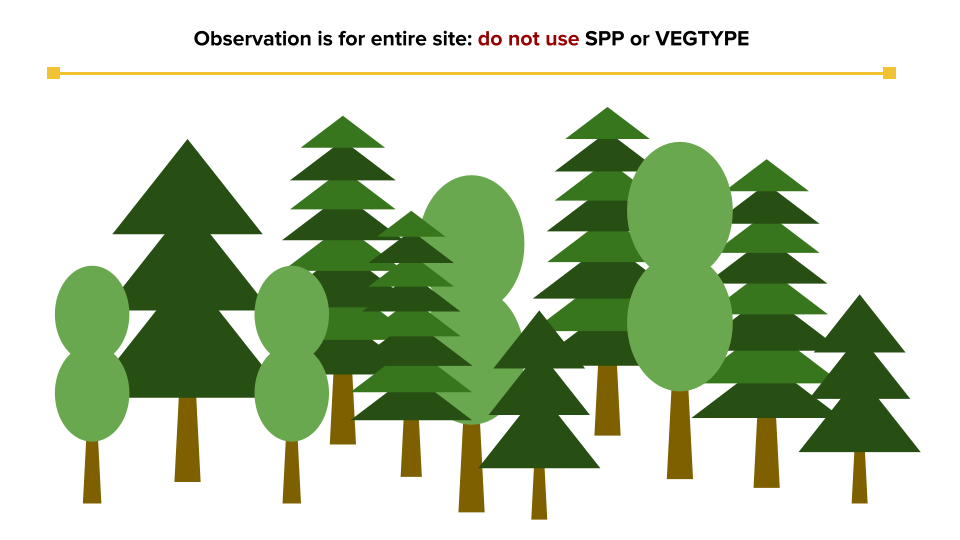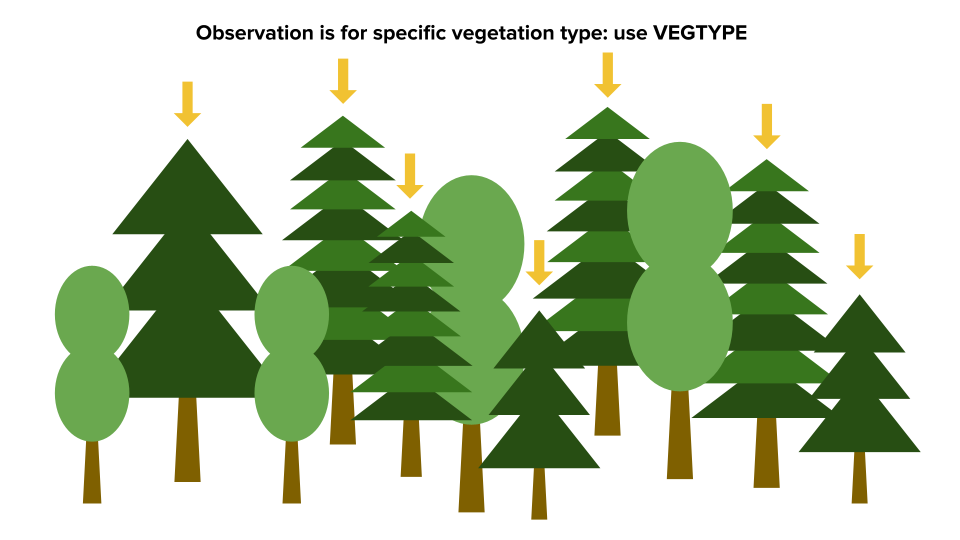BADM Group Overview
BADM variables in this group are organized as shown below. The overview highlights what variables are required per group. It also indicates which variables cannot be specified together ( OR ) in the same group entry. See BADM Basics for more details.
Multiple entries of this BADM group can be reported per site. However, combinations of Ⓒ variables must be unique. Read more:
Optional Variable
Ⓒ Combinations
Examples
| Required | Optional | |||||||||||||||
|---|---|---|---|---|---|---|---|---|---|---|---|---|---|---|---|---|
Basal Area |
|
|
BADM variables: Definitions, Units, Requirements
See Overview tab or BADM Basics for explanation of Required and Optional variables.
Multiple entries of this BADM group can be reported per site. However, combinations of Ⓒ variables must be unique. Read more:
Optional Variable
Ⓒ Combinations
Examples
| Variable Requirements | Units | Description |
|---|---|---|
| BASAL_AREA Required | m2 ha-1 | Basal area The area of central tree trunks (stems) measured at 1.3 meters from the soil surface (breast height) for a given land surface area. If reporting basal area at a different height, report the height in Approach. Report the minimum tree size threshold for trees to be included in the mean Basal area measurement in BASAL_AREA_MIN. |
| BASAL_AREA_SPP Ⓒ Optional-a | Scientific name | Basal area species (taxa) Vegetation species being described by the measurement. To enter a plant species, use the scientific name (Genus species Author or Genus Author). Please refer to www.theplantlist.org for current scientific names and authors. If the measurement includes all vegetation present, do not enter a value. Do not use SPP if reporting VEGTYPE. |
| BASAL_AREA_VEGTYPE Ⓒ Optional-a | LIST(VEGTYPE) Show | Basal area vegetation type Use the predefined list to indicate the type of vegetation being described by the measurement (e.g., Tree, Evergreen Tree, Deciduous Tree). If the measurement includes all vegetation present, do not enter a value. Not all VEGTYPE options are appropriate for DBH measurement. If vegetation type is not in predfined list, enter "Other/Not in list" and describe briefly in Approach. Do not use VEGTYPE if reporting SPP. |
| BASAL_AREA_STATISTIC Ⓒ Required | LIST(STATISTIC) Show | Basal area statistic The statistic for the measurement reported. Use predefined list (e.g., mean, min / max, standard deviation, etc). |
| BASAL_AREA_STATISTIC_METHOD Ⓒ Optional | LIST(STATISTIC_METHOD) Show | Basal area statistic method Method used to generate the reported statistic (e.g., aggregate of individuals, aggregate of sample aggregates) from observations representing the same time period. Use predefined list. The aggregation method is not meant to describe temporal aggregations for example in calculations of higher frequency observations (e.g., sub-minute) to lower frequency observations (e.g., hourly) at a single location. |
| BASAL_AREA_STATISTIC_NUMBER Optional | integer number | Number of observations used to determine basal area statistic Number of observations (samples / replicates) used to calculate the STATISTIC for the reported measurement. |
| BASAL_AREA_DBH_MIN Optional | cm | Minimum tree size (diameter) threshold for basal area measurement The diameter at 1.3m from the soil surface (breast height) above which trees are included in the basal area measurement. |
| BASAL_AREA_APPROACH Optional | free text | Basal area measurement approach |
| BASAL_AREA_DATE Ⓒ Required-b | YYYYMMDDHHMM | Basal area measurement date Please report the date at the precision known. Allowed reporting precisions are YYYY, YYYYMM, YYYYMMDD, and YYYYMMDDHHMM. For measurements conducted during a campaign or for temporal averages, use DATE_START and DATE_END instead of DATE. |
| BASAL_AREA_DATE_START Ⓒ Required-b | YYYYMMDDHHMM | Start date of basal area measurment Start date of a measurement campaign or start date of a temporal average. Please report the date at the precision known. Allowed reporting precisions are YYYY, YYYYMM, YYYYMMDD, and YYYYMMDDHHMM. Do not use DATE_START if DATE is used. |
| BASAL_AREA_DATE_END Required | YYYYMMDDHHMM | End date of basal area measurment End date of a measurement campaign or end date of a temporal average. Please report the date at the precision known. Allowed reporting precisions are YYYY, YYYYMM, YYYYMMDD, and YYYYMMDDHHMM. Do not use DATE_END if DATE is used. |
| BASAL_AREA_DATE_UNC Optional | days | Uncertainty in the basal area measurement date, start date, and/or end date If uncertainty in the start date differs than end date, report the uncertainty for start date here in DATE_UNC and the uncertainty for end date in Comments. |
| BASAL_AREA_COMMENT Optional | free text | Basal area comments |
BADM Examples
Choose a variable marked with to show examples of how to submit and interpret these BADM. See BADM Basics for more details.
Combinations of Ⓒ variables must be unique. Read more: .
Optional Variable
Ⓒ Combinations
Examples
| Basal Area |
Customize and Download CSV for BADM Submission
After selecting your desired variables, download the customized CSV file for submission of BADM. For additional submission details, see BADM Submission Instructions. See BADM Basics for general BADM details.
Multiple entries of this BADM group can be reported per site. However, combinations of Ⓒ variables must be unique. Read more: . See BADM Basics for more details.
Optional Variable
Ⓒ Combinations
Examples
| Required | Optional | |||||||||||||||||
|---|---|---|---|---|---|---|---|---|---|---|---|---|---|---|---|---|---|---|
|
|
Submit completed CSV file at Upload Data using the BADM option (login required).








